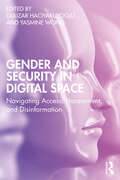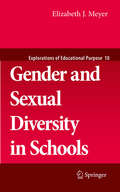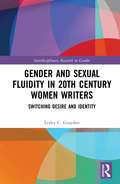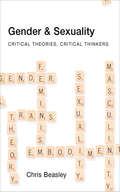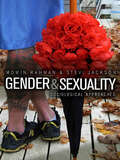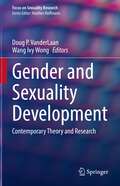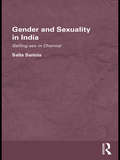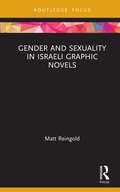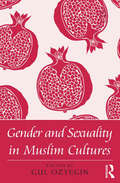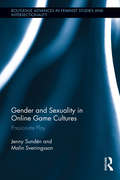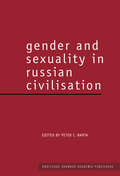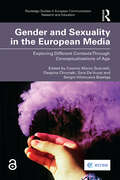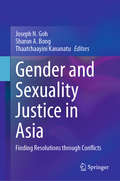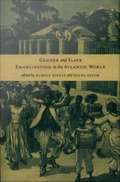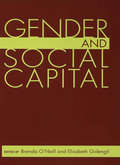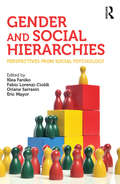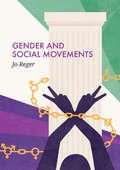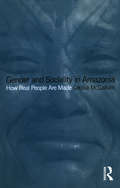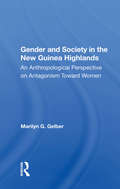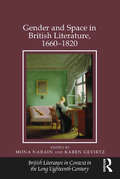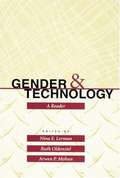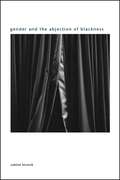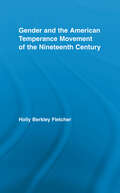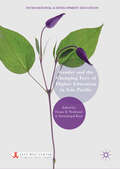- Table View
- List View
Gender and Security in Digital Space: Navigating Access, Harassment, and Disinformation
by Gulizar Haciyakupoglu Yasmine WongDigital space offers new avenues, opportunities, and platforms in the fight for gender equality, and for the social, economic, and political participation of women and marginalised communities. However, the very same space plays host to gender inequalities and security threats with gendered implications. This edited volume ventures into complexities at the intersection of gender, security, and digital space, with a particular focus on the persistent problems of access, harassment, and disinformation. Scholars and practitioners in this volume tackle various facets of the issue, presenting an array of research, experiences, and case studies that span the globe. This knowledge lends itself to potential policy considerations in tackling inequalities and threats with gendered implications in cyber space towards digital spaces that are safe and equal. This book is a must-read for students, scholars, and practitioners seeking to expand their knowledge on the gendered threats in digital space and potential remedies against them.
Gender and Self in Islam (Routledge Advances in Middle East and Islamic Studies #Vol. 10)
by Etin AnwarUsing philosophical analysis, this book explores the construction of gender in Muslim societies and its implication to the constitution of the self. The root of the existing discourse of the hierarchical principle is examined as is the extent to which the process of human reproduction, especially the role of women in conception, contributes to an anti-egalitarian theory of gender. The author analyzes the theological, cultural and political apparatus of the masculine conception of femininity and seeks to unfold the process of the alienation of the self from a woman’s sense of individuality, agency, and autonomy. Incorporating traditional Islamic sources, Western feminist texts and Christian texts, Gender and Self in Islam seeks to restructure the contradictory claims of gender hierarchy and egalitarianism and elaborate an alternative set of interpretations that is friendly and inclusive of women.
Gender and Sexual Diversity in Schools
by Elizabeth J. MeyerIssues related to gender and sexual diversity in schools can generate a lot of controversy, with many educators and youth advocates under-prepared to address these topics in their school communities. This text offers an easy-to-read introduction to the subject, providing readers with definitions and research evidence, as well as the historical context for understanding the roots of bias in schools related to sex, gender, and sexuality. Additionally, the book offers tangible resources and advice on how to create more equitable learning environments. Topics such as working with same-sex parented families in elementary schools; integrating gender and sexual diversity topics into the curriculum; addressing homophobic bullying and sexual harassment; advising gay-straight alliances; and supporting a transgender or gender non-conforming student are addressed. The suggestions offered by this book are based on recent research evidence and legal decisions to help educators handle the various situations professionally and from an ethical and legally defensible perspective.
Gender and Sexual Fluidity in 20th Century Women Writers: Switching Desire and Identity (Interdisciplinary Research in Gender)
by Lesley C GraydonThis book analyses twentieth-century writers who traffic in queer, non-normative, and/or fluid gender and sexual identities and subversive practices, revealing how gender and sexually variant women create, revise, redefine, and play with language, desires, roles, the body, and identity. Through the model of the "switch" —someone who shifts between roles, desires, or ways of being in the realms of gender or sexual identity – Gender and Sexual Fluidity in 20th Century Women Writers: Switching Desire and Identity examines the intersecting locations of gender and sexual identity switching that six prolific, experimental authors and their narratives play with: Gertrude Stein, Jeanette Winterson, Kathy Acker, Eileen Myles, Anne Carson, and Anne Carson’s translations of Sappho. The theory and identities revealed create and give space to—by their playful, exploratory, and destabilizing nature—diverse openings and possibilities for a great expansion and freedom in gender, sexuality, desires, roles, practices, and identity. This is a provocative and innovative intervention in gender and sexuality in modern literature and gives us a new vocabulary and conversation by which to expand women’s and gender studies, LGBTQ and sexuality studies, identity studies, literature, feminist theory, and queer theory.
Gender and Sexuality: Critical Theories, Critical Thinkers
by Chris BeasleyThis accessible introduction to gender and sexuality theory offers a comprehensive overview and critique of the key contemporary literature and debates in feminism, sexuality studies and men's studies. Chris Beasley's clear and concise introduction combines a wide-ranging survey of the major theorists and key concepts in an ever-growing and often passionately debated field. The book contextualizes a wide range of feminist perspectives, including: modernist, liberal, postmodern, queer and gender difference feminism; and in the realm of sexuality studies covers modernist liberationism, social constructionism, transgender theorising and queer theory. In men's studies, Chris Beasley examines areas of debate ranging from gender and masculinity to questions of race, ethnicity, imperialism and gay masculinities. Interconnections between the subfields are highlighted, and Beasley considers the implications of body theory for all three. Key theorists covered include: Altman· Brod· Butler · Califia· Carbado· Connell· Dowsett ·Grosz· Halberstam· Hook · Jackson· Jagose· Nussbaum· Rich· Seidman· Spivak· Stoltenberg· Weeks· Whittle· Wolf· Wollstonecraft The only book of its kind to draw together all the important strands of gender analysis, Gender and Sexuality is a timely and impressive overview that is invaluable to students and academics taking courses on gender and feminist theory, sexuality and masculinity.
Gender and Sexuality: Sociological Approaches (Gender And Culture Ser.)
by Momin Rahman Stevi JacksonThis new introduction to the sociology of gender and sexuality offers a fresh take on the importance of these concepts in modern society. It provides an insight into our rapidly changing attitudes towards sex and our understanding of masculine and feminine identities, relating the study of gender and sexuality to wider social concerns throughout the world and presenting a comprehensive yet readable summary of recent research and theory. In an accessible and engaging style, the book demonstrates how thinking about gender and sexuality can illuminate and enliven other contemporary sociological debates about social structure, social change, and culture and identity politics. Emphasis is placed on the diversity of gendered and sexual lives in different parts of the world. The book offers detailed coverage of wide-ranging topics, from international sex-tourism to celebrity culture, from gender in the work-place to new sexual lifestyles, drawing examples from everyday life. By demonstrating the links between gender and sexuality this book makes a clear case for thinking sociologically about these important and controversial aspects of human identity and behaviour. The book will be of great value to students in any discipline looking to understand the roles gender and sexuality play in our lives.
Gender and Sexuality Development: Contemporary Theory and Research (Focus on Sexuality Research)
by Doug P. VanderLaan Wang Ivy WongThis book showcases a wealth of knowledge and insight on gender and sexuality development. With contributions from leading researchers, it covers a comprehensive set of topics at the forefront of the field and strikes a balance between traditional and emerging areas of study. Given that gender and sexuality are shaped by myriad influences, this book is modelled on an interdisciplinary perspective and delves into biological, comparative, psychological, cognitive, social, cultural, and clinical approaches. In so doing, this collection conveys the rich tapestry of gender and sexuality science and will hold value for many. For those already in the field, this book provides an excellent resource for brushing up on the latest and for inspiring the next phases of scientific investigation. Those who are newer to the field, including undergraduate and graduate students, stand to gain tremendously from not only the thoughtful and informative content, but also from the interdisciplinary approach modelled throughout the book. Beyond academia, this book is a valuable resource for clinicians and policy makers who deal with child and adolescent issues.
Gender and Sexuality in India: Selling Sex in Chennai (Routledge/Edinburgh South Asian Studies Series)
by Salla SariolaIndia has one of the highest numbers of HIV carriers in the world. HIV has remained associated with sex work, and large sums of money provided to fund public health interventions have come from global institutions such as UNAIDS, the World Bank and USAID. In the midst of these processes, however, sex workers and their everyday lives have been hidden behind the rhetorics of control and prevention. This book offers a detailed analysis of the experiences of sex workers in Chennai. Based on ethnographic fieldwork, it draws out themes of agency; notions of gender and sexuality; and the HIV prevention industry. While the women’s experiences are closely knit into the medical discourse regarding sex workers, sex work emerges as a complicated knot of poverty, desire, women’s oppression, love, co-option, and motherhood. The author examines how the sex workers actively negotiate the risks of their industry and suggests alternative discourses on women’s sexuality, sexual behaviour and desire, arguing that unless the power imbalances affecting women are addressed, such policies and activities will have little impact. She brings attention to the problems of current policies, discourses and attitudes regarding HIV, sexuality and sex work, and shows how new policies could help to reduce vulnerabilities not only for sex workers, but perhaps for all women in India.
Gender and Sexuality in Israeli Graphic Novels (Routledge Focus on Gender, Sexuality, and Comics)
by Matt ReingoldThis book explores how Israeli graphic novelists present depictions of masculinity and femininity that differ from conventional portrayals of gender in Israeli society, rejecting the ways that hypermasculinity and docile femininity have come to be associated with men and women. The book is the first to explore Israeli graphic novels through the lens of gender. It argues that breaking down existing gender delineations with regards to masculinity and femininity is a core feature of the Israeli graphic novel and comics tradition and that through their works, the authors and artists use their platforms to present a freer and looser conceptualization of gender for Israeli society. Undertaking close readings of Israeli graphic novels that have been published in English and/or Hebrew in the last 20 years, the book’s texts include Rutu Modan’s Exit Wounds and The Property, Ari Folman and David Polonsky’s Waltz with Bashir, Galit and Gilad Seliktar’s Farm 54, and Asaf Hanuka’s "The Realist". This book is of interest to students and scholars in comics studies, Israel Studies, Jewish Studies, and Gender Studies.
Gender and Sexuality in Muslim Cultures
by Gul OzyeginA must-read for anyone interested in Muslim cultures, this volume not only explores Muslim identities through the lens of sexuality and gender - their historical and contemporary transformations and local and global articulations - but also interrogates our understanding of what constitutes a ’Muslim’ identity in selected Muslim-majority countries at this pivotal historical moment, characterized by transformative destabilizations in which national, ethnic, and religious boundaries are being re-imagined and re-made. Contributors take on the most fundamental questions at the intersections of gender, sexuality, and the body. Several overarching questions frame the volume: How does studying gender and sexuality expand and enrich our understanding of Muslim-majority countries, historically and at present? How does the embodiment of ’Muslim’ identity get reconfigured in the context of twenty-first-century globalism? What analytical questions are raised about ’Islam’ when its diverse meanings and multifaceted expressions are closely examined? What roles do gender and sexuality play in the construction of cultural, religious, nationalistic, communal, and militaristic identities? How have power struggles been signified in and on the bodies of women and sexuality? How have global dynamics, such as the intensification and spread of neoliberal ideologies and policies, affected changing dynamics of gender and sexuality in specific locales? Here global dynamics touch down in diverse contexts, from masculinity crises around war disabilities, transnational marriages, and fathering in Turkey, Egypt, and Pakistan; to Muslim femininity narratives around female genital cutting, sexuality in divorce proceedings, and spouse selection; to gender crossing practices as well as protesting bodies, queering voices, and claims of authenticity in literary and political discourse. This book brings exciting research on these and other topics together in one place, allowing the essa
Gender and Sexuality in Online Game Cultures: Passionate Play (Routledge Advances in Feminist Studies and Intersectionality)
by Jenny Sundén Malin SveningssonHow do gender and sexuality come to matter in online game cultures? Why is it important to explore "straight" versus "queer" contexts of play? And what does it mean to play together with others over time, as co-players and researchers? Gender and Sexuality in Online Game Cultures is a book about female players and their passionate encounters with the online game World of Warcraft and its player cultures. It takes seriously women’s passions in games, and as such draws attention to questions of pleasure in and desire for technology. The authors use a unique approach of what they term a "twin ethnography" that develops two parallel stories. Sveningsson studies "straight" game culture, and makes explicit that which is of the norm by exploring the experiences of female gamers in a male-dominated gaming context. Sundén investigates "queer" game culture through the queer potentials of mainstream World of Warcraft culture, as well as through the case of a guild explicitly defined as LGBT. Academic research on game culture is flourishing, yet feminist accounts of gender and sexuality in games are still in the making. Drawing on feminist notions of performance, performativity and positionality, as well as the recent turn to affect and phenomenology within cultural theory, the authors develop queer, feminist studies of online player cultures in ways that are situated and embodied.
Gender and Sexuality in Russian Civilisation (Routledge Harwood Studies in Russian and European Literature)
by Peter I. BartaGender and Sexuality in Russian Civilisation considers gender and sexuality in modern Russia in the nineteenth and early twentieth centuries. Chapters look individually at gender and sexuality through history, art, folklore, philosophy or literature,but are also arranged into sections according to the arguments they develop. A number of chapters also consider Russia in the Soviet and post-Soviet periods. Thematic sections include:*Gender and Power*Gender and National Identity*Sexual Identity and Artistic Impression*Literary Discourse of Male and Female Sexualities*Sexuality and Literature in Contemporary Russian Society
Gender and Sexuality in the European Media: Exploring Different Contexts Through Conceptualisations of Age (Routledge Studies in European Communication Research and Education)
by Cosimo Marco ScarcelliThis edited collection brings together original empirical and theoretical insights into the complex set of relations which exist between age, gender, sexualities and the media in Europe. This book investigates how engagements with media reflect people’s constructions and understandings of gender in society, as well as articulations of age in relation to gender and sexuality; the ways in which negotiations of gender and sexuality inform people’s practices with media, and not least how mediated representations may reinforce or challenge social hierarchies based in differences of gender, sexual orientation and age. In doing so, it showcases new and innovative research at the forefront of media and communication practice and theory. Including contributions from both established and early career scholars across Europe, it engages with a wide range of hotly debated topics within the context of gender, sexuality and the media, informing academic, public and policy agendas. This collection will be of interest to students and researchers in gender studies, media studies, film and television, cultural studies, sexuality, ageing, sociology and education.
Gender and Sexuality Justice in Asia: Finding Resolutions through Conflicts
by Joseph N. Goh Sharon A. Bong Thaatchaayini KananatuThis book brings together a group of innovative scholars examining the contemporary issue of effecting gender and sexuality justice in the context of Asia, consonant with engendering a just, equitable and sustainable development for all. These grassroots initiatives are woven through three complementary sections of the book: gender justice in Asia, sexuality justice in Asia, and finding resolutions through conflict. The book foregrounds strategies that aim to call out and challenge existing gender and sexuality injustices with regard to women and the LGBTIQA+ community by: assessing the efficacy of gender mainstreaming policies through micro-credit schemes for women in East Java, Indonesia; proliferating the signifiers of the hijab (veil) by postmodern Malay-Muslim women or ‘Hijabistas’ within the consumerist culture of Malaysia; making visible the injustices of the Syariah legal system for non-Muslim women, and ground-breaking legislation that could potentially recognise same-sex marriages in Thailand; privileging the narratives of gay women diplomats within the highly masculinised field of diplomacy in the Asia-Pacific region; foregrounding the narratives of Filipino gay men, intimate partner violence among young Indonesian Christian young people, masculine-identifying lesbians in Singapore, young LGBT people in rural Vietnam, and a Chinese-Muslim Malaysian female-to-male transgender person; and proposing new ways of becoming an inclusive church through the radical act of befriending persons living with HIV and AIDS in Southeast Asia. This book celebrates diverse and inclusive voices and strategies of gender and sexual agents of change in envisioning and bringing to fruition a just and transformative society for all. It is of interest to students and scholars researching gender and sexuality in areas of development studies, international relations, socio-legal studies, and literary studies.
Gender and Slave Emancipation in the Atlantic World
by Pamela Scully Diana PatonThis groundbreaking collection provides the first comparative history of gender and emancipation in the Atlantic world. Bringing together essays on the United States, Brazil, Cuba, Puerto Rico, West Africa and South Africa, and the Francophone and Anglophone Caribbean, it shows that emancipation was a profoundly gendered process, produced through connections between race, gender, sexuality, and class. Contributors from the United States, Canada, Europe, the Caribbean, and Brazil explore how the processes of emancipation involved the re-creation of gender identities--the production of freedmen and freedwomen with different rights, responsibilities, and access to citizenship. Offering detailed analyses of slave emancipation in specific societies, the contributors discuss all of the diverse actors in emancipation: slaves, abolitionists, free people of color, state officials, and slave owners. Whether considering the construction of a postslavery masculine subjectivity in Jamaica, the work of two white U. S. abolitionist women with the Freedmen's Bureau after the Civil War, freedwomen's negotiations of labor rights in Puerto Rico, slave women's contributions to the slow unraveling of slavery in French West Africa, or the ways that Brazilian abolitionists deployed representations of femininity as virtuous and moral, these essays demonstrate the gains that a gendered approach offers to understanding the complex processes of emancipation. Some chapters also explore theories and methodologies that enable a gendered reading of postslavery archives. The editors' substantial introduction traces the reasons for and patterns of women's and men's different experiences of emancipation throughout the Atlantic world. Contributors. Martha Abreu, Sheena Boa, Bridget Brereton, Carol Faulkner, Roger Kittleson, Martin Klein, Melanie Newton, Diana Paton, Sue Peabody, Richard Roberts, Ileana M. Rodriguez-Silva, Hannah Rosen, Pamela Scully, Mimi Sheller, Marek Steedman, Michael Zeuske
Gender and Social Capital (Gender Politics--Global Issues)
by Elisabeth Gidengil Brenda O'NeillThe volume brings together a stellar group of contributors who examine the social capital thesis by means of four different approaches: theoretical, historical, comparative, and empirical. In the end, this book will serve to answer two fundamental questions which have hitherto been neglected: What can a gendered analysis tell us about social capital? And what can social capital tell us about women and politics?
Gender and Social Hierarchies: Perspectives from social psychology
by Eric Mayor Klea Faniko Fabio Lorenzi-Cioldi Oriane SarrasinGender and Social Hierarchies offers a fresh and coherent picture of applied research from within social psychology on the intricate relationship between gender and social status. It comprises a collection of innovative approaches which seek to understand the pervasiveness of status asymmetry between gender categories. Drawing upon recent theoretical advances in gender psychology, the book provides tools for developing practical and political recommendations to address and resolve status inequality today. Each chapter examines a different aspect of the impact that gender-based social hierarchies have on people’s lives. Part One explores the consequences of gender stereotypes in school, higher education, and in professional settings. The struggles faced by women in the workplace are discussed in Part Two, featuring topics such as work-life balance, the ‘glass cliff’, and the lack of support for affirmative action. Part Three is devoted to the antecedents and consequences of gender-based forms of prejudice, such as discrimination against gay men, and against women within cultural minorities. The book concludes with some practical suggestions for working towards lasting and beneficial change. Gender and Social Hierarchies will appeal to scholars and students across the social sciences and offers important insights to practitioners and policy-makers.
Gender and Social Movements (Social Movements)
by Jo RegerHow does gender influence social movements? How do social movements deal with gender? In Gender and Social Movements, Jo Reger takes a comprehensive look at the ways in which people organize around gender issues and how gender shapes social movements. Here gender is more than an individual quality, it is a part of the very foundation of social movements, shaping how they recruit, mobilize and articulate their strategies, tactics and identities. Moving past the gender binary, Reger explores how movements can shift understandings of gender and how backlash and countermovements can often follow gendered movement successes. Adopting both an intersectional and global lens, the book introduces readers to the idea that gender as a form of societal power is integral in all efforts for social change. With a critical overview across different types of movements and gender activism, such as the women’s liberation, #Metoo and transgender rights movements, this book offers a solid foundation for those seeking to understand how gender and social movements interact.
Gender and Sociality in Amazonia: How Real People Are Made
by Cecilia McCallumThis is the first book to focus directly on gender in Amazonia for nearly thirty years. Research on gender and sexual identity has become central to social science during that time, but studies have concentrated on other places and people, leaving the gendered experiences of indigenous Amazonians relatively unexplored. McCallum explores little-known aspects of the day-to-day lives of Amazonian peoples in Brazil and Peru. Taking a closer look at the lives of the Cashinahua people, the book provides fascinating insights into conception, pregnancy and birth; naming rituals and initiation ceremonies; concepts of space and time; community and leadership; exchange and production practices; and the philosophy of daily life itself. Through this prism it shows that in fact gender is not merely an aspect of Amazonian social life, but its central axis and driving force. Gender does not just affect personal identity, but has implications for the whole of community life and social organization. The author illustrates how gender is continually created and maintained, and how social forms emerge from the practices of gendered persons in interaction. Throughout their lives, people are 'being made' in this part of the Amazon, and the whole of social organization is predicated on this conception. The author reveals the complex inter-relationships that link gender distinctions with the body, systems of exchange and politics. In so doing, she develops a specific theoretical model of gender and sociality that reshapes our understanding of Amazonian social processes. Building on the key works from past decades, this book challenges and extends current understandings of gender, society and the indigenous people of Amazonia.
Gender And Society In The New Guinea Highlands: An Anthropological Perspective On Antagonism Toward Women
by Marilyn G. GelberThe societies of the New Guinea Highlands are among the last-contacted horticulturalist peoples of the world. Endemic warfare, elaborate systems of exchange, flamboyant personality styles, and exaggerated forms of antagonism between the sexes have made them a subject of interest to anthropologists for three decades. This book examines the relationship between the sexes, especially the attitudes and behavior of men toward women, as a result of the economic, political, and structural constraints of Highland social organization. Hostility toward women, which is evident in a high level of violence toward women and an articulated fear of association with them, is given special attention. Dr. Gelber's study is unique not only because it treats gender relations in the entire culture area of the Highlands, but also because a broad array of types of anthropological analysis—ecosystemic, population-regulatory, economic, sociopolitical, psychological, and ideational—are considered for their relevance to the phenomenon of intersexual hostility. The author's emphasis on underlying problems of explanation and theory, as well as the treatment of attitudes and beliefs as a function of socioeconomic constraints, is a departure from previous modes of analysis and raises new issues in anthropological theory and in the study of gender.
Gender and Space in British Literature, 1660-1820 (British Literature in Context in the Long Eighteenth Century)
by Mona Narain Karen GevirtzBetween 1660 and 1820, Great Britain experienced significant structural transformations in class, politics, economy, print, and writing that produced new and varied spaces and with them, new and reconfigured concepts of gender. In mapping the relationship between gender and space in British literature of the period, this collection defines, charts, and explores new cartographies, both geographic and figurative. The contributors take up a variety of genres and discursive frameworks from this period, including poetry, the early novel, letters, and laboratory notebooks written by authors ranging from Aphra Behn, Hortense Mancini, and Isaac Newton to Frances Burney and Germaine de Staël. Arranged in three groups, Inside, Outside, and Borderlands, the essays conduct targeted literary analysis and explore the changing relationship between gender and different kinds of spaces in the long eighteenth century. In addition, a set of essays on Charlotte Smith’s novels and a set of essays on natural philosophy offer case studies for exploring issues of gender and space within larger fields, such as an author’s oeuvre or a particular discourse. Taken together, the essays demonstrate space’s agency as a complement to historical change as they explore how literature delineates the gendered redefinition, occupation, negotiation, inscription, and creation of new spaces, crucially contributing to the construction of new cartographies in eighteenth- and early nineteenth-century England.
Gender and Technology: A Reader
by Nina E. Lerman Ruth Oldenziel Arwen P. MohunFor most of human experience, certainly of late, the artifacts of technological civilization have become closely associated with gender, sometimes for physiological reasons but more often because of social and cultural factors, both obvious and obscure.
Gender and the Abjection of Blackness (SUNY series in Gender Theory)
by Sabine BroeckIn Gender and the Abjection of Blackness, Sabine Broeck argues that gender studies as a mostly white field has taken insufficient account of Black contributions, and that more than being an ethnocentric limitation or blind spot, this has represented a structural anti-Blackness in the field. Engaging with the work of Black feminist authors Sylvia Wynter, Hortense Spillers, and Saidiya Hartman, Broeck critiques a selection of canonical white gender studies texts to make this case. The book discusses this problem at the core of gender theory as a practice which Broeck terms enslavism—the ongoing abjection of Black life which Hartman has called the afterlife of slavery. This has become manifest in the repetitive employment of the "woman as slave" metaphor so central to gender theory, as well as in recent theoretical mutations of these anti-Black politics of analogy. It is the structural separation of Blackness from gender that has functioned over and again as the scaffold enabling white women's struggles for successful recognition of equality and subjectivity in the human world as we know it. This book challenges white readers to rethink their own untroubled identification with gender theory, and it provides all readers with a white feminist theorist's sophisticated theoretical and self-critical scholarly account of her own reckoning with and learning in dialogue from Black feminism's critique.
Gender and the American Temperance Movement of the Nineteenth Century (Studies in American Popular History and Culture)
by Holly Berkley FletcherDuring the nineteenth century, the American temperance movement underwent a visible, gendered shift in its leadership as it evolved from a male-led movement to one dominated by the women. However, this transition of leadership masked the complexity and diversity of the temperance movement. Through an examination of the two icons of the movement -- the self-made man and the crusading woman -- Fletcher demonstrates the evolving meaning and context of temperance and gender. Temperance becomes a story of how the debate on racial and gender equality became submerged in service to a corporate, political enterprise and how men’s and women’s identities and functions were reconfigured in relationship to each other and within this shifting political and cultural landscape.
Gender and the Changing Face of Higher Education in Asia Pacific (International and Development Education)
by Deane E. Neubauer Surinderpal KaurThis book establishes gender issues as a major focus within developments shaping higher education in the Asia Pacific region. The discussion is framed as a response to various dedicated efforts, such as that of the United Nations, to foreground gender as a site for political discourse throughout the region. Throughout the volume, authors confront issues that continue to gain prominence in higher education as a policy arena, including the degree to which higher education operates within a framework of gender equity and how higher education appointments—even promotions—are sensitive to gender. By touching specific instances throughout Korea, Japan, China, Australia, India, Malaysia, Thailand, and Taiwan, authors offer an unprecedented big-picture view of gender-relevant policy issues.
